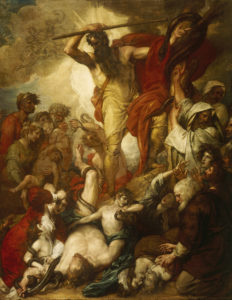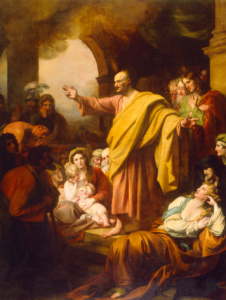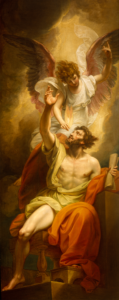In this painting, Benjamin West captures one of the most dramatic events in Israel’s history.
Tag Archives: St. George’s Chapel
This tender, graceful work by Benjamin West is one of a special series of paintings commissioned by King George III to decorate a chapel at Windsor Castle.
Visit HERE for the next video to think on things that are Worthy of Praise.
The Brazen Serpent
Oil on canvas, 1790
Benjamin West, P.R.A.
American, active in England, 1738–1820
Roughly three years before the treaty ending the Revolutionary War, King George III commissioned Benjamin West to create a special series of paintings for the chapel at Windsor Castle. West, who had become one of the leading artists in England and Historical Painter to the King in 1772, considered this commission to be the “great work of [his] life.” The Progress of Revealed Religion would cover Biblical history from “commencement to completion.” To understand more about this royal commission, the artist, and M&G’s distinction of displaying the largest assembly of completed paintings from the series, read St. Peter Preaching at Pentecost.
West’s choices for the series’ subjects and organization were probably influenced by William Warburton, who wrote about the parallels between the Old and New Testaments and specifically how the Old Testament laid the foundation for the New Testament work of the Messiah, Jesus Christ. The artist chose and outlined his visual narratives for the chapel into four dispensations: creation and fall of man (pre-Mosaic law), the Israelite nation under Mosaic law, Christ’s life and dispensation of grace, and the last judgment.
M&G’s The Brazen Serpent fits within the dispensation focused on the Israelite nation under Mosaic law. The life of Moses is remarkable from birth to death. God called him to lead the enslaved Hebrew nation out of Egypt to Canaan, the Promised Land. From the outset, the journey was challenging. As the Hebrews arrived at the Red Sea, their Egyptian masters followed them, and the situation looked dire. The overwhelmed children of Israel responded by crying, blaming God and Moses, and complaining about their circumstances—a cycle of responses that the infant nation would repeat. God miraculously parted the waters into two heaps while the large caravan crossed on dry land to the other side. As the Egyptians started through the waters, God closed the path with the Red Sea crashing down and destroying them instead—the first of His many provisions and blessings. God’s presence and leading were visible with a pillar of clouds by day and fire by night. He supplied fresh water, manna (bread of heaven), victory over enemies, clothing and shoes that didn’t wear out. On Mt. Sinai, God gave the Ten Commandments to Moses for the help of Israel’s development as a distinctive nation protected by God. God outlined unique worship features and a sanctuary designed for praise, prayer, and offerings to Jehovah alone. He chose this people and made a special covenant with them.
Even with these physical and spiritual blessings, the Israelites griped about the food (wishing for leeks and onions of Egypt, meat, etc.), their thirst for water, Moses’ leadership, fear of the “giants” in the land God promised them. Their recurring lack of gratitude led to judgment, including the curse to wander in the wilderness for 40 years, until the complaining generation (with the exception of Joshua and Caleb) had all died. Only their children would enter the land of promise. Following a victory over the Canaanites as they neared the border of the Promised Land, once again “the people spoke against God and Moses, ‘Why have you brought us up out of Egypt to die in the wilderness? For there is no food and no water, and our soul loathes this worthless bread.’ So the Lord sent fiery serpents among the people, and they bit the people; and many of the people of Israel died” (Numbers 21:4-9).
As on previous occasions, the people begged Moses to pray to God for their forgiveness, admitting they had sinned against the Lord and him. Moses prayed, and the Lord commanded him to “Make a fiery serpent, and set it on a pole; and it shall be that everyone who is bitten, when he looks at it, shall live. So, Moses made a bronze serpent, and put it on a pole.” Instead of taking away the punishment, God mercifully provided a remedy in the form of a brass serpent. Whoever turned to view the brazen serpent was healed. Individuals could make their choice: they could look and live or choose death.
Helmut van Erffa and Alan Staley consider The Brazen Serpent to be “one of the most successful full-scale paintings for the chapel.” In West’s powerful visual narrative, he included snakes everywhere—biting and coiling themselves around the people, and even some in the air (upper left). West owned a collection of Renaissance and Baroque engravings, which he often referenced for inspiration. The drama of this work borrows from both Peter Paul Rubens’ Brazen Serpent and the famous sculpture from antiquity of Laocoön and his sons (figure group at the lower left of the painting). However, the figure of Moses reflects the muscular strength and monumentality of Michelangelo’s style.
In the distance between Moses’ feet, the camp tents are barely visible, but filling the foreground (and our ears’ imagination) are a variety of emotional responses expressed by these suffering people. Compassionate, fearful mothers carry their children to view the bronze serpent. Some men are praying or pointing the way for others to look and be healed. Others are in the stages of recovery, while a few mourn over those who have died. West’s composition leads the eyes upward to the light breaking from heaven and silhouetting the figure of Moses—the brightest part of the painting, where there is hope, the cure.
Centuries after the great patriarch’s death, Nicodemus, a knowledgeable teacher of the Jewish Sanhedrin, came to Jesus by night for answers. To illustrate how one can enter God’s kingdom, Christ explained His coming crucifixion and hope of salvation, “And as Moses lifted up the serpent in the wilderness, even so must the Son of Man be lifted up, that whoever believes in Him should not perish but have eternal life” (John 3:14-15).
Erin R. Jones, Executive Director
Published 2021
St. Peter Preaching at Pentecost
Oil on canvas, signed and dated 1785
Benjamin West, P.R.A.
American, active in England, 1738–1820
Benjamin West was born the youngest of ten children to Quakers John and Sarah West on October 10, 1738 in the township of Springfield, Pennsylvania. At an early age, he showed remarkable artistic talent by painting likenesses of his family. True or not, charming anecdotes have been passed down that the Indians instructed him in preparing colors and that Benjamin made his first paintbrush by plucking tail and back hairs from Gremalkin, the family cat.
At nine, he met a British portraitist, William Williams, who genuinely inspired the young boy. He lent West two books about painting, which developed in him an enduring interest in both the great historians who recorded the stories of the noble and virtuous and the great master painters who depicted the lofty scenes of Scripture and the past.
West continued to paint portraits and at age 18, following his mother’s death, he moved to Philadelphia to live with his married sister. There, he benefited from the mentoring of Rev. William Smith, a respected scholar, minister, and intellectual. Smith found a way for West (age 22, armed with letters of introduction) to travel to Rome, where the great artists studied. West was the first American artist to travel to Italy, where he not only studied and copied the Old Masters and sculpture of Greek and Roman antiquity, but he befriended the contemporary Neoclassical painters including Anton Raphael Mengs and Pompeo Batoni.
In 1763, West moved to England and joined the Society of Artists, where he exhibited and earned the nickname, “the American Raphael”—it was the beginning of a successful career and a lifetime of commissions. Along with Sir Joshua Reynolds and other artists, the king made West a charter member of the Royal Academy.
Defying precedent, West pursued a controversial approach in 1770 for the first exhibition of the Royal Academy by painting The Death of General Wolfe. The scene portrayed a moment of recent history—the heroic death of a great general during Britain’s Seven Years War with France in North America. Rather than following the day’s expectation of clothing the characters in robes of antiquity, West painted the men wearing modern dress. It was a milestone in English and American art, and it established his artistic reputation.
West became England’s leading Neoclassical painter and historical painter to King George III. Following Reynolds’ death, West was made the 2nd president of the Royal Academy and the longest serving. West’s success and recognition attracted art students from America. He gave them opportunities to study and assist on commissions in his studio, where he trained three generations of American artists, including Charles Wilson Peale and Gilbert Stuart. As the “Father of American Painting,” he helped establish a sophisticated American style and provided a foundation for the growth of the arts in America during the Federal period.
In 1780, King George commissioned West to decorate a proposed chapel at Windsor Castle “for the purpose of displaying a pictorial illustration” of subjects from the Bible, “which Christians of all denominations, might contemplate without offense to their tenets.” West developed multiple plans for the chapel over a 20-year period, so it is difficult to know the total paintings he intended to complete. According to records from 1801, his concept for the Chapel of the History of Revealed Religion contained approximately 35 paintings featuring the Scriptural events when God specifically revealed Himself to man.
M&G’s St. Peter Preaching at Pentecost is one of the paintings originally planned for the king’s chapel. The festival of Pentecost brought many visitors from around the known world to Jerusalem. The disciples were gathered together on the feast day when suddenly the sound of a rushing wind filled the house. Flames of fire appeared above their heads, and they were filled with the Holy Spirit and began to speak in other languages. Others at the feast thought the disciples were drunk, but Peter powerfully preached to the assembled crowd, who understood what he spoke in their own language. He explained to them that the miracle they were observing was the fulfillment of Joel’s prophecy and that Jesus came to save them from their sins, died, and was resurrected on the third day. Three thousand people believed on Jesus Christ that day.
West beautifully and subtly displays this New Testament event from Acts 2, by representing the presence of the Holy Spirit with a smoky quality and the slightest hint of faintly glowing flames above Peter’s head and John’s (behind Peter and wearing green and red). The crowd scene is an observer’s study in reading people. Each person responds differently as they intently consider the apostle’s words. One of West’s special details is the mother with her two young children, which references his skill as a portraitist.
Of course, many factors prevented the chapel and commission from being finished including the American and French Revolutions and the king’s ongoing health struggles. However, West completed 18 large paintings for the chapel and left one unfinished. Of those 18 finished works, 5 are now lost, which leaves 13 paintings with known locations. Six can be found in the collections at the National Gallery in DC, the Pennsylvania Academy of Fine Art, the Palace of Westminster in London, the Tate Gallery, Margram Castle in Neath, and St. Martin’s Church in Wales. Remarkably, M&G displays the remaining 7 paintings all together in the War Memorial Chapel on the campus of Bob Jones University.
These are no ordinary pictures, and they represent the creative talent and skill of the first, significant American artist. Art historian Alfred Scharf has honored these works as “the most outstanding series of religious paintings in 18th-century England.”
Erin R. Jones, Executive Director
Published in 2020
The Ascension
Benjamin West, P. R. A.
Below the image, click play to listen.
To learn more about the entire series to which this painting belongs, visit here.

In 1963, the Museum & Gallery acquired seven canvases from Benjamin West’s large series, The Progress of Revealed Religion. Originally, King George III of England had commissioned West to paint this series for the king’s proposed private chapel, St. George’s, at Windsor Castle. However, because of the king’s illness and eventual madness, the chapel was never renovated, the entire series was never completed, and the paintings were never hung at Windsor. After West’s death, the completed part of the series was separated. Out of the thirteen known, extant works in the world from West’s series, seven of the paintings reside in the War Memorial Chapel on the campus of Bob Jones University.
If you’re interested in seeing the Benjamin West collection while M&G is closed, consider bringing a tour group. Learn more here.
These works from the series are represented in M&G’s Collection and on view:
The Ascension
St. Peter Preaching at Pentecost
Isaiah’s Lips Anointed with Fire
Christ Coming Up Out of the Jordan
Moses and Aaron before Pharaoh
Esau and Jacob Presented to Isaac
The Brazen Serpent



